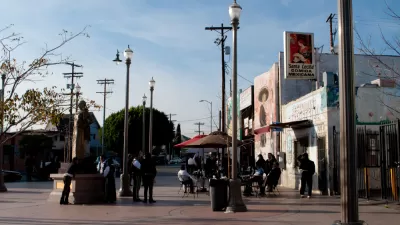Before his death in March, Hussle has plans for an opportunity zone investment fund that would ensure the community wouldn’t lose out in the development process.

Angel Jennings reports on rapper Nipsey Hussle’s plans for economic development in South Los Angeles. In March, Hussle was killed in front of his clothing store and the building he had purchased with David Gross, his development partner, in the Hyde Park neighborhood.
Jennings says Hussle and Gross wanted to take advantage of the federal opportunity zones tax benefits to spur projects in Hyde Park:
The tax incentive that Gross and Hussle were planning to tap was promoted by [Sen. Tim] Scott and included in President Trump’s 2017 overhaul of the federal tax code. It offers potentially large tax breaks to investors who are willing to pour much needed capital into rebuilding poor and sometimes up-and-coming communities that have been designated as "opportunity zones."
Critics have argued that the status of some designated opportunity zones as economically disadvantaged is questionable. In addition, advocates are concerned about the gentrification and displacement effects of these investments. Hussle's plan sought to address these issues through partnerships with community organizations and city leaders to ensure local residents benefited from development in the area.
Hussle, who grew up in South Los Angeles, was behind several development projects, including a co-working space and STEM center. When Hyde Park was designated an opportunity zone, he worked with Gross on a plan for the neighborhood, writes Jennings:
Hussle and Gross wanted to build on the L-shape strip mall — home of the Marathon Clothing — which they bought in January. They were going to add 80 units of apartments and condos on top of shops with healthy food options. Like with the larger investment fund, the duo wanted to make their neighbors their business partners. They were going to set aside 20% of the housing units for residents of the neighborhood, and invest with them so they could own their homes, Gross said.
Before Hussle's death, he and Gross had started meeting with lawmakers and investors about the "Our Opportunity" investment fund. "The plan was to crowdfund from each community and give residents an ownership stake in every project created in their neighborhood," says Jennings.
FULL STORY: Nipsey Hussle had a plan to beat gentrification — in South L.A. and across the U.S.

Alabama: Trump Terminates Settlements for Black Communities Harmed By Raw Sewage
Trump deemed the landmark civil rights agreement “illegal DEI and environmental justice policy.”

Planetizen Federal Action Tracker
A weekly monitor of how Trump’s orders and actions are impacting planners and planning in America.

The 120 Year Old Tiny Home Villages That Sheltered San Francisco’s Earthquake Refugees
More than a century ago, San Francisco mobilized to house thousands of residents displaced by the 1906 earthquake. Could their strategy offer a model for the present?

In Both Crashes and Crime, Public Transportation is Far Safer than Driving
Contrary to popular assumptions, public transportation has far lower crash and crime rates than automobile travel. For safer communities, improve and encourage transit travel.

Report: Zoning Reforms Should Complement Nashville’s Ambitious Transit Plan
Without reform, restrictive zoning codes will limit the impact of the city’s planned transit expansion and could exclude some of the residents who depend on transit the most.

Judge Orders Release of Frozen IRA, IIJA Funding
The decision is a victory for environmental groups who charged that freezing funds for critical infrastructure and disaster response programs caused “real and irreparable harm” to communities.
Urban Design for Planners 1: Software Tools
This six-course series explores essential urban design concepts using open source software and equips planners with the tools they need to participate fully in the urban design process.
Planning for Universal Design
Learn the tools for implementing Universal Design in planning regulations.
Clanton & Associates, Inc.
Jessamine County Fiscal Court
Institute for Housing and Urban Development Studies (IHS)
City of Grandview
Harvard GSD Executive Education
Toledo-Lucas County Plan Commissions
Salt Lake City
NYU Wagner Graduate School of Public Service





























